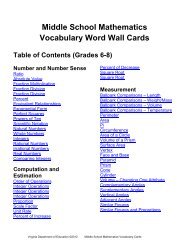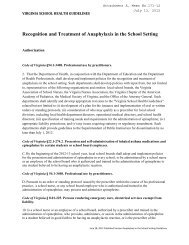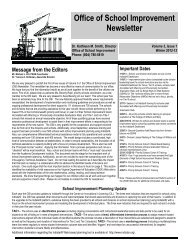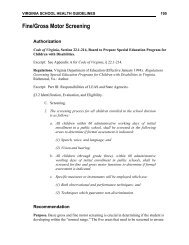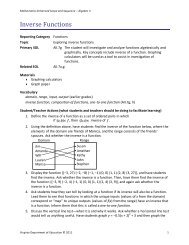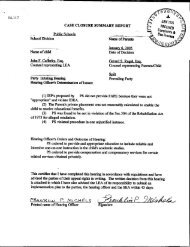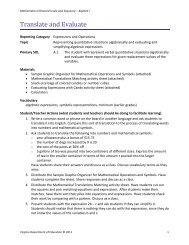What Makes Something Alive - Virginia Department of Education
What Makes Something Alive - Virginia Department of Education
What Makes Something Alive - Virginia Department of Education
Create successful ePaper yourself
Turn your PDF publications into a flip-book with our unique Google optimized e-Paper software.
Keep a record <strong>of</strong> where each insect was found.<br />
Collecting insects out-<strong>of</strong>-doors can be as simple as a hands and knees inspection <strong>of</strong> any piece<br />
<strong>of</strong> lawn, a bush, or the bark <strong>of</strong> a tree. A plastic container can be used to scoop up and discovery<br />
for closer examination.<br />
Catching flying insects with a butterfly net is more difficult then it appears. A sweep net is a<br />
much more efficient method <strong>of</strong> collecting a large number and wide variety <strong>of</strong> insects. Flies,<br />
moths, ladybugs, leaf hoppers, and gnats are some <strong>of</strong> the insects that can be easily collected<br />
using this equipment.<br />
A long-handled, fine mesh net is swept back and forth just brushing the top <strong>of</strong> grass or weeds.<br />
The idea is to sweep any insects buzzing around and among the grass and weeds into the net.<br />
After 15 or 20 swipes, swing the net around swiftly above your head to concentrate the animals.<br />
Then grasp the top <strong>of</strong> the net to form a bag and to keep them from escaping.<br />
Collected insects can be transferred for closer inspection into smaller plastic bags.<br />
Larger insects like crickets and grasshoppers can be collected by hand and transferred to<br />
plastic bags or jars. A sheet <strong>of</strong> plastic pulled to the ground by two students usually traps<br />
grasshoppers safely.<br />
While sweeping is a great way to catch many flying and hopping insects, small beetles, sow<br />
bugs and other low to the ground insects that are not usually captured in sweep nets can be<br />
added to your collection using pitfall traps.<br />
Pill bottles, small juice cans or similar containers can be placed in holes in the ground the same<br />
size as the container. Small holes are punched or drilled into the bottom <strong>of</strong> the trap to let water<br />
drain.<br />
Place a little bait such as candy crumbs, meat, or peanut butter at the bottom on the trap. Traps<br />
should be left for at least eight hours or overnight. Insects captured in the pitfall traps are then<br />
transferred to the containers for comparisons with insects captured earlier.<br />
Once your collecting safari is complete, suggest to the students that they should describe and<br />
compare their collection as if these insects have been discovered for the first time.<br />
The following questions can be used to help guide their inquiry:<br />
<strong>What</strong> are the most prominent features (body parts) <strong>of</strong> each insect? <strong>What</strong> do they<br />
appear to be used for?<br />
Does the insect have wings? How many? How are they attached to the body?<br />
Can you locate a mouth? <strong>What</strong> foods does the mouth seem suitable for?<br />
Where are the eyes located? How many? Are they like the eyes <strong>of</strong> mammals? How<br />
are they different?<br />
35<br />
<strong>Virginia</strong> Animals and their Habitats<br />
Topic 2 – Session 2.2<br />
Insect Safari Lesson Plans



